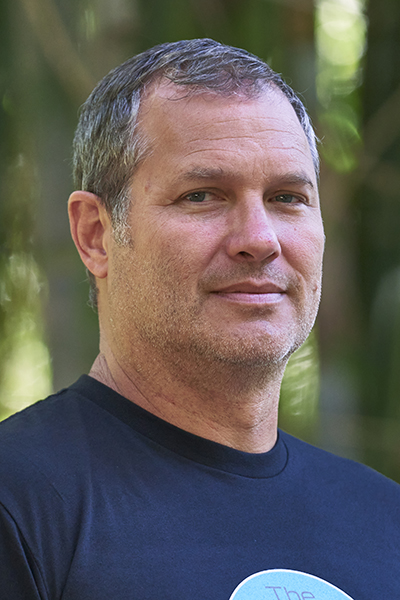
Paul Barber
Professor
email: paulbarber@ucla.edu
phone: (310) 794-5349
office: 2145 Terasaki Life Sciences Building (TLSB)
website
Recent Courses
EE BIOL 109 - Introduction to Marine Science
EE BIOL 97X - PEERS Forum: Pathways in Science
EE BIOL 97X - PEERS Forum: Pathways in Science
Research Interests
Our laboratory integrates genetics, ecology, oceanography and geology to understand the processes that promote speciation in marine environments, creating marine biodiversity hotspots. For the past decade, we have focused on the fish and invertebrates of the coral reefs of the Coral Triangle, the global epicenter of marine biodiversity. Through a comparative approach, we are examining the relative importance of tectonic history, physical oceanography, and organismal ecologies in limiting genetic connectivity and promoting evolution and lineage diversification. Our recent work focuses on integrating empirical models of connectivity with predictions from geographically explicit models of contemporary and historical ocean currents. We work closely with conservation organizations such as Conservation International to translate our basic science into information that can help guide conservation planning, protecting these endangered reef ecosystems. We are also interested in the role of natural selection and adaptation in shaping population genetic patterns, particularly the role of the genetic basis of energetic performance of mitochondrial in size selective mortality of marine larvae.
Selected Publications
Liu, S.Y.V., Frederich, B. , Lavoue, S., Chang, J., Erdmann, M.V., Mahardika, G.N., Barber, P.H., "Buccal venom gland associates with increased of diversification rate in the fang blenny fish Meiacanthus (Blenniidae; Teleostei)", Molecular Phylogenetics and Evolution, 125 : 138-146 (2018) .
Fong, C.R., Chancellor, K.S., Renzi, J.J., De'Marcus, R.R., Barber, P.H., Habtes, S.Y., Fong, P., "Epibionts on Turbinaria ornata, a secondary foundational macroalga on coral reefs, provide diverse trophic support to fishes", Marine Environmental Research, 125 : - (2018) [link].
Keyse, J., Treml, E.A., Huelsken, T., Barber, P.H., DeBoer, T., Kochzius, M., Nuryanto, A., Gardner, J.P.A., Liu, L.L., Penny, S., Riginos, C., "Historical divergences associated with intermittent land bridges overshadow isolation by larval dispersal in co?distributed species of Tridacna giant clams", Journal of Biogeography, 45 : 848-858 (2018) [link].
Pertiwi, N.I.P.D., , Nugraha, B., Sulistyanigsigh, R.K., Jatmiko, I., Sembiring, A., Mahardidni, A., Cahyani, N.K.D., Anggoro. A.W., Madduppa, H.H., Barber, P.H., Mahardika, G.N., "Lack of differentiation within the bigeye tuna population of Indonesia", BioIdiversitas Journal of Biological Diversity, 18 : 1406-1413 (2017) .
Willette, D.A., Simmonds, S.E., Cheng, S.H., Esteves, S., Kane, T.L., Nuetzel, H., Pilaud, N., Rachmawati, R. and Barber, P.H., "Using DNA barcoding to track seafood mislabeling in Los Angeles restaurants", Conservation Biology, 31 (5): 1076-1085 (2017) [link].
Leasi, F., Gaynus, C., Mahardini, A., Moore, T.N., Norenburg, J.L. and Barber, P.H., "Spatial and ecologic distribution of neglected microinvertebrate communities across endangered ecosystems: meiofauna in Bali (Indonesia)", Marine Ecology, 37 (5): 970-987 (2016) [link].
Aguilar-Medrano, R. and P.H. Barber, "Ecomorphological diversification in reef fish of the genus
Abudefduf (Percifomes, Pomacentridae)", Zoomorphology, 37 (5): - (2015) [link].
Willette, DA, Iniguez, AR, Kupriyanova, EK, Starger, CJ, Varman, T, Toha, AH, Maralit, BA, Barber, PH, "Christmas tree worms of Indo-Pacific coral reefs: untangling the Spirobranchus corniculatus (Grube, 1862) complex", Zoomorphology, Coral Reefs 34 (3): 899-904 (2015) .
Toven-Lindsey, B., Levis-Fitzgerald, M., Barber, P.H., Hasson, T., "Increasing Persistence in Undergraduate Science Majors: A Model for Institutional Support of Underrepresented Students", CBE-Life Sciences Education, 14 (2): ar12- (2015) .
Faurby, S. & P.H. Barber, "Extreme population subdivision despite high colonization ability: Contrasting regional patterns in intertidal tardigrades from the west coast of North America", Journal of Biogeography, 42 : 1006-1017 (2015) .
